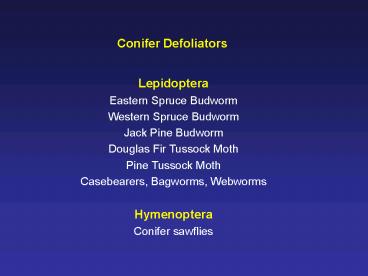Conifer Defoliators - PowerPoint PPT Presentation
1 / 54
Title: Conifer Defoliators
1
Conifer Defoliators
Lepidoptera Eastern Spruce Budworm Western Spruce
Budworm Jack Pine Budworm Douglas Fir Tussock
Moth Pine Tussock Moth Casebearers, Bagworms,
Webworms Hymenoptera Conifer sawflies
2
Eastern Spruce Budworm
Natural Resources Canada, CFS., Laurentian For.
Cent., Pierre Therrien
Native Insect Eastern Canada, New England,
Upper Midwest Balsam Fir, White Spruce, Other
Spruces Large - Scale, Cyclic Outbreaks
3
Natural Resources Canada, Can. For. Serv.,
Laurentian For. Cent., René Pâquet
4
Natural Resources Canada, Can. For. Serv.,
Laurentian For. Cent., Claude Monnier
5
Natural Resources Canada, Can. For. Serv.,
Laurentian For. Cent., Jacques Morissette
6
(No Transcript)
7
(No Transcript)
8
Natural Enemies
Predators Birds Parasitoids Eggs Trichogramma
minutum (Chalcidae) Early larvae Apanteles
fumiferanae (Braconidae) Late larvae Actia
interrupta (Tachinidae) Meteorus
thrichynotus (Braconidae) Pupae Itoplectus
conquistidor (Ichneumonidae) Pathogens NPHV Nos
ema (Protozoa) Fungi
Relationship to Population Cycles
9
Impacts
Tree-Level 1 yr 30-90 radial growth loss
Flower cone mortality 2 - 3 yr Root
mortality Top death Mortality to
bark beetles 4 yr Tree death
Stand-Level Conversion to early succession
plants Fire Nutrient cycling Altered wildlife
10
Population Cycles
Major outbreaks _at_ 25 yrs. Intensified by Forest
Management Practices Key Factors Dispersal and
Establishment of early instar larvae Stand
Structure Phenological Coincidence with Opening
Buds Host Relationships Overall Nutrients more
important than Toxins Protein more important
than Carbohydrates Early instars in Late season
Foliage - low in N Third instars in Early
season Buds - high N and protein, but they
must be open (e.g., Black spruce
asynchron) Late instars in Mid season Foliage-
low N, high Carbohydrates
11
Sampling
Aerial Photos Landscape Pheromones Egg
Mass and Larval Surveys Tree
Good sampling protocols available at each level
12
Jack Pine Budworm
13
Jack Pine Budworm
14
Jack Pine Budworm Host Specificity
15
Conifer Defoliators
Lepidoptera Spruce Budworm Jack Pine
Budworm Douglas Fir Tussock Moth Pine Tussock
Moth Casebearers, Bagworms, Webworms Hymenoptera
Conifer sawflies
16
Douglas Fir Tussock Moth
17
Douglas Fir Tussock Moth (Lymantriidae)
Native Species Northwest from Cascades to
Continental Divide Eruptive Population
Dynamics Wingless Females
18
Life Cycle of Douglas Fir Tussock Moth
Univoltine Overwinter as Eggs Larvae emerge in
spring Disperse aerially Host Range Douglas
Fir True Firs
19
Impact of Douglas Fir Tussock Moth Tree Level 50
- 75 Growth Reduction Susceptibility to Bark
Beetles Stand Level Released understory growth
Conversion to pine Increased nutrient cycling
from frass clipped needles 10X available N
20
Population Dynamics of Douglas Fir Tussock Moth
Intrinsic Cycles - Every 8 - 9 yrs. Delayed
density dependence between herbivore and natural
enemies Control by generalists and parasites
-gtRelease -gt Virus Site Weather Factors Edge
of natural range of host (DF / Fir - Pine
Grass) Warm, dry conditions Shallow
Soils Forestry Practices Conversion from pine to
DF or Fir Fire suppression Grazing
21
Douglas Fir Tussock Moth Natural Enemies
Generalists Birds Nuthatch, Junco
Chickadees Ants Specialists Parasitoids
NPV
22
Management of Douglas Fir Tussock Moth
Silviculture Preventative Site selection based
on risk rating Susceptible Sites Low
elevations East slopes Ridge tops High tree
density Large crowns High DF, Fir
Preventative Management Favor soil moisture
and nutrient cycling processes Avoid
compaction Thinning Retain slash
Warm, dry
Larval dispersal
23
Management of Douglas Fir Tussock Moth
Silviculture Corrective Sanitation
harvest Favor natural regeneration Sampling Aer
ial photography satellites Pheromones Egg
mass and larval sampling Insecticides Bt
Consider Timing, Role of host trees NPV Pheromone
s
24
Conifer Defoliators
Lepidoptera Spruce Budworm Jack Pine
Budworm Douglas Fir Tussock Moth Pine Tussock
Moth Casebearers, Bagworms, Webworms Hymenoptera
Conifer sawflies
25
Pine Tussock Moth (Lymantriidae)
Native Species Jack Pine (Rarely others) Mostly
in WI, MN
26
Larvae feed on current foliage in spring
Larvae emerge in late summer. Feed on
eggs. Overwinter as L2-3
Adults in mid summer
Oviposit on foliage
Pupate on foliage
27
(No Transcript)
28
Pine Tussock Moth Natural Enemies
29
Budworms vs. Tussock Moths
30
Conifer Defoliators
Lepidoptera Spruce Budworm Jack Pine
Budworm Douglas Fir Tussock Moth Pine Tussock
Moth Casebearers, Bagworms, Webworms Hymenoptera
Conifer sawflies
31
Larch Casebearer
Introduced Feeds only on larch Throughout range
of larch Originally caused large-scale
outbreaks Now largely controlled by Introduced
parasitic wasp Occassional outbreaks
32
Larch Casebearer
33
Larch Casebearer Feeding
Univoltine Overwinter as pupa Feed in summer
34
Bagworms Biology, Impact, Control
35
Pine False Webworm
UGA1247144
36
Conifer Defoliators
Lepidoptera Spruce Budworm Jack Pine
Budworm Douglas Fir Tussock Moth Pine Tussock
Moth Casebearers, Bagworms, Webworms Hymenoptera
Conifer sawflies
37
Sawfly Life Cycle Mating Oviposition
Facultative parthenogenisis Sexual dimorphism
38
Oviposit in Needle Use ovipositor to slit resin
flow
Multiple eggs per needle
39
Sawfly Egg
40
Early Instar Sawfly Larvae
41
Sawfly Larvae
42
Sawfly Larvae Feeding on Prior Years Foliage
43
(No Transcript)
44
Sawfly Cocoon in Soil
45
Sawfly Prepupae in Cocoons
46
(No Transcript)
47
Sawfly Larval Defensive Regurgitation Against
Predators
48
Sawfly Larval Resin Pouches for Defensive
Regurgitation
49
Natural Enemies of Conifer Sawflies Parasitoids Ch
ickadees Some generalist arthropods
50
Sawfly Eggs Killed by Pine Needle Dessication
51
Redheaded Pine Sawfly
Broad host range Feeds on both previous and
current years foliage Intermittent outbreaks in
young plantations Populations build along
hardwood edge
52
European Pine Sawfly Scots, Austrian 1 generation
/ yr. Introduced Pine Sawfly White pine (Jack,
Scots, Red) Christmas Trees Early larvae
Gregarious Late larvae Solitary Pupate on
tree 2 generations / yr. European Spruce
Sawfly White spruce
53
Larch Sawfly
Larch only Population almost entirely female 1
generation / yr.
Female oviposits under bark of current twigs
Oviposition causes shepherds crooking Larvae
feed gregariously on foliage on previous years
twigs
54
Regionally Important Conifer Defoliators
Lepidoptera Needle Miners Lodgepole needle
miner Silkworm Moths Pandora Moth on ponderosa
and lodgepole pine Inchworms (Geometridae)
Western Hemlock Looper Coastal range Eastern
Hemlock Looper Newfoundland Sulfur Butterflies
Pine Butterfly on ponderosa pine Coleoptera Scara
baeidae Pine chafer































